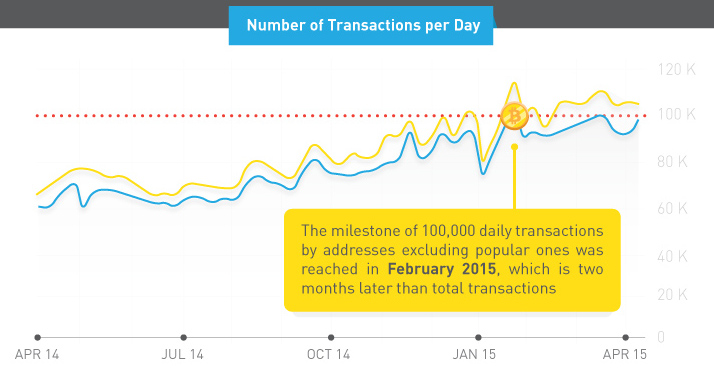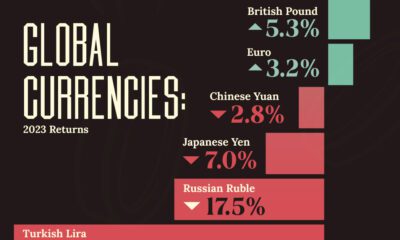Technology
Bitcoin is Finally Becoming an “Everyday Use” Currency

Bitcoin is Finally Becoming an “Everyday Use” Currency
Over the last few years, Bitcoin has gained a reputation as an investment commodity. It has been toted as a method to preserve wealth and to hedge against currency devaluation as bitcoins cannot be “printed”.
This reputation still holds true today. With Greece’s economy on the rocks and the unfolding aftermath of a “no” decision, the bitcoin price has skyrocketed by around 20% in the last month. While Greeks are having difficulties buying the cryptocurrency due to capital controls, Coinbase has reported that buys across Europe have increased 300% as others observe what is happening in Greece.
However, recent transaction data also shows that more bitcoins are being spent on “everyday use” items. Bitpay, which facilitates retail transactions using bitcoins, reports that the number of transactions has increased from 209,420 to 563,568 (from 2013 to 2014). Interestingly, the average order amount decreased substantially from $513 to $281 per order as more people bought more everyday items.
What are people buying with bitcoins? It turns out the list is pretty boring: bedroom sheets, headphones, area rugs, mattresses, coffee tables, sunglasses, and donations to non-profits all help round out the top ten items bought on Overstock.com. With the cryptocurrency becoming more ubiquitous as shown by reaching the 100k daily transaction mark (not including popular addresses) this year, it is being used more and more for regular ecommerce purchases.
As we’ve previously shown with technology hype cycles, it takes some time for new innovations to develop the infrastructure to reach their hyped potential. There is evidence that shows that cryptocurrencies and Bitcoin are along this path. Even though they are primed to change the world and spur even more innovation, the world has not yet been ready. It seems to be getting closer, though.
Original graphic by: Coupofy
Technology
All of the Grants Given by the U.S. CHIPS Act
Intel, TSMC, and more have received billions in subsidies from the U.S. CHIPS Act in 2024.

All of the Grants Given by the U.S. CHIPS Act
This was originally posted on our Voronoi app. Download the app for free on iOS or Android and discover incredible data-driven charts from a variety of trusted sources.
This visualization shows which companies are receiving grants from the U.S. CHIPS Act, as of April 25, 2024. The CHIPS Act is a federal statute signed into law by President Joe Biden that authorizes $280 billion in new funding to boost domestic research and manufacturing of semiconductors.
The grant amounts visualized in this graphic are intended to accelerate the production of semiconductor fabrication plants (fabs) across the United States.
Data and Company Highlights
The figures we used to create this graphic were collected from a variety of public news sources. The Semiconductor Industry Association (SIA) also maintains a tracker for CHIPS Act recipients, though at the time of writing it does not have the latest details for Micron.
| Company | Federal Grant Amount | Anticipated Investment From Company |
|---|---|---|
| 🇺🇸 Intel | $8,500,000,000 | $100,000,000,000 |
| 🇹🇼 TSMC | $6,600,000,000 | $65,000,000,000 |
| 🇰🇷 Samsung | $6,400,000,000 | $45,000,000,000 |
| 🇺🇸 Micron | $6,100,000,000 | $50,000,000,000 |
| 🇺🇸 GlobalFoundries | $1,500,000,000 | $12,000,000,000 |
| 🇺🇸 Microchip | $162,000,000 | N/A |
| 🇬🇧 BAE Systems | $35,000,000 | N/A |
BAE Systems was not included in the graphic due to size limitations
Intel’s Massive Plans
Intel is receiving the largest share of the pie, with $8.5 billion in grants (plus an additional $11 billion in government loans). This grant accounts for 22% of the CHIPS Act’s total subsidies for chip production.
From Intel’s side, the company is expected to invest $100 billion to construct new fabs in Arizona and Ohio, while modernizing and/or expanding existing fabs in Oregon and New Mexico. Intel could also claim another $25 billion in credits through the U.S. Treasury Department’s Investment Tax Credit.
TSMC Expands its U.S. Presence
TSMC, the world’s largest semiconductor foundry company, is receiving a hefty $6.6 billion to construct a new chip plant with three fabs in Arizona. The Taiwanese chipmaker is expected to invest $65 billion into the project.
The plant’s first fab will be up and running in the first half of 2025, leveraging 4 nm (nanometer) technology. According to TrendForce, the other fabs will produce chips on more advanced 3 nm and 2 nm processes.
The Latest Grant Goes to Micron
Micron, the only U.S.-based manufacturer of memory chips, is set to receive $6.1 billion in grants to support its plans of investing $50 billion through 2030. This investment will be used to construct new fabs in Idaho and New York.
-

 Energy1 week ago
Energy1 week agoThe World’s Biggest Nuclear Energy Producers
-

 Money2 weeks ago
Money2 weeks agoWhich States Have the Highest Minimum Wage in America?
-

 Technology2 weeks ago
Technology2 weeks agoRanked: Semiconductor Companies by Industry Revenue Share
-

 Markets2 weeks ago
Markets2 weeks agoRanked: The World’s Top Flight Routes, by Revenue
-

 Countries2 weeks ago
Countries2 weeks agoPopulation Projections: The World’s 6 Largest Countries in 2075
-

 Markets2 weeks ago
Markets2 weeks agoThe Top 10 States by Real GDP Growth in 2023
-

 Demographics2 weeks ago
Demographics2 weeks agoThe Smallest Gender Wage Gaps in OECD Countries
-

 United States2 weeks ago
United States2 weeks agoWhere U.S. Inflation Hit the Hardest in March 2024














